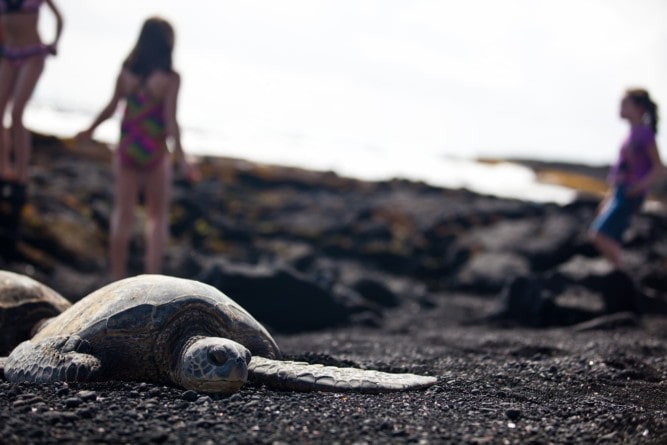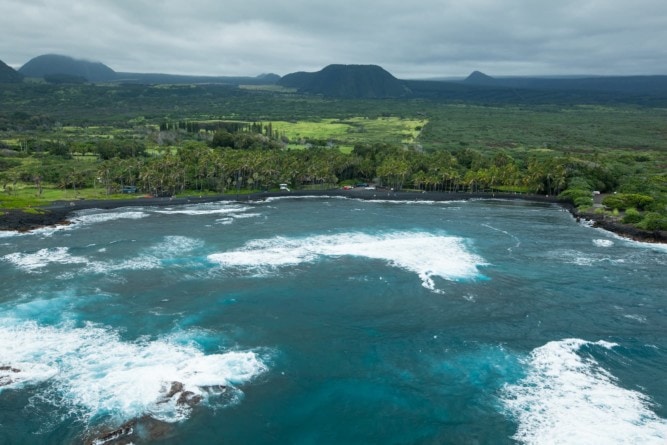Beaches on the Big Island are a prime destination for tourists. Big Island’s black sand beaches are jaw-droppingly beautiful!
The state of Hawaiʻi’s best black sand beaches may be found here. Let us know if we’ve forgotten one or if you’ve already been to a few of the places on our list.

Table of Contents
Black sand beaches on the Big Island
Punaluʻu Beach
Punaluʻu Beach is situated on the southern end of the Big Island between the towns of Pahala and Naʻalehu. Punaluʻu is a Hawaiian term that approximately translates to “coral dived for” or “spring diver” or “to dive for corals”, and has to do with the history of the beach.
Black sand beaches were created as a result of volcanic eruptions. As fresh lava enters the ocean it often fragments (explodes) in many tiny shards, that in turn get eroded by the ocean until they are fine grains of black sand. That means that the black sand you can find on Punaluʻu once got spit out as red-hot molten lava by the Kilauea volcano!

Turtles at Punaluʻu
You can often find green sea turtles (“Honu” in Hawaiian) on the beach, and sometimes also an endangered Hawksbill turtle. The large amount of visiting turtles make this one of the most popular black sand beaches to visit on the island.
People are not permitted to touch the turtles since doing so may damage their immune systems, rendering them vulnerable to illnesses. NOAA and DLNR recommend, for your safety and the animals’ protection, that everyone stay at least 10 feet (3 meters) from all sea turtles.
Practicalities
Punaluʻu beach is accessible to the public from 8:30 a.m. until 5:00 p.m., and to ensure the safety of swimmers and snorkelers there are lifeguards on duty to monitor the activities of swimmers and divers.
Restrooms, parking, bathrooms, picnic areas, and a boat ramp, are amenities you can find there. The beach is not open to pets.

Although Punaluʻu Beach is remote, it is fairly accessible, in comparison to some of Hawaii’s other black sand beaches.
Pohoiki Beach
Pohoiki Beach is a black sand beach in the Puna district that is part of the Isaac Kepoʻokalani Hale Beach Park.
The 2018 Kilauea Volcano eruption created Pohoiki Beach as Lava spilled into the water along many miles to the each of the park. Luckily the eruption spared the park itself, but a lot of black sand was carried to the beach by the ocean currents thus creating the new black sand beach.

The park is open from 9 a.m. to 6 p.m. every day and there are restrooms near the beach, but camping or picnicking are not allowed.
Careful: swimming on the beach is not recommended due to the strong currents.
Kaimu Beach
Located in the lush Puna district, Kaimu beach is another black sand beach that was formed during a 1990 eruption of the Kilauea Volcano. The eruption itself covered the region where one of the most beautiful beaches ever stood at Kalapana. Old Kalapana beach now is buried by around 70 feet of lava that poured onto the beach during the eruption.

Due to the strong current, swimming and snorkeling are not advised. The beach itself is a short hike over lava fields from the parking lot at Kalapana. A 10-minute trek will take you past layers of lava that sometimes rises 7 or 8 feet above the path, before you reach the beach. Because there are no amenities in the immediate area, this location is solely suited for sightseeing, for example as part as a road trip through Puna.
Polulu Valley Beach
This black sand beach was created when a large portion of the now extinct Kohala volcano fell into the water approximately 100,000 years ago. The Kohala volcano is Hawaii’s oldest.
Polulu Valley Beach is a black sand beach with a magnificent emerald-green ground cover of native plants inland. The green color contrasts with the black sand and the water, making it very picturesque.

Hiking down the cliff into the valley is the only way to get down to the beach area. It’s a short, steep, and rewarding trek. Hiking in the rainy season, on the other hand, might be hazardous due to the increased slickness. Hiking the 0.6-mile-long cliff to the valley level will take an average hiker around 25 minutes.
Due to undertows, large rocks in the water, and high tides, the water is not suitable for swimming.
If you keep an eye out to sea, you may get a glimpse of a humpback whale. There are no lifeguards or amenities on this Hawaiian beach, which sits at the very end of Highway 270 in Kohala.
Note that the parking lot can get very busy, so try to visit this beach early (sunrises from the Pololu overlook are stunning!).
Kehena Beach
Kehena Beach is located on Hawaii island’s eastern shore and was created by lava from a volcanic 1955 eruption. Because of the spinner dolphins that sometimes frequent the beach, this black sand beach is sometimes called Dolphin Beach.
The beach is long but narrow, and there are rocks on each end of the beach that limiting the water current at the beach.

Located again in the Puna district, you’ll find Kehana off Highway 137. Due to the beach trail’s steepness, getting to the beach involves a strenuous climb.
Kehana beach is one of Hawaii’s most distinctive beaches due to its designation as a ‘clothing optional’ beach, which is quite uncommon in Hawaii. As a result, only visit if you are not perturbed by nudity.
Swimming is permitted, however care is advised due to the swim area’s tiny size and the possibility of harmful currents.
Waipiʻo Valley Black Sand Beach
Waipiʻo is a Hawaiian term that literally translates as ‘curved water.’ This black sand beach in Hawaii can only be reached by driving down one of the steepest roads in the country!
Access to Waipiʻo Valley Black Sand Beach is restricted, and the route is only accessible to vehicles equipped with four-wheel drive. No rental car provider that we know of allows their cars to be taken down the access road to the beach. This means that you can get to the beach either by joining a tour or by walking down.
When hiking down the access road turn right at the valley floor. An average hiker may complete this trail in 35 to 45 minutes going down. Count on at least an hour for the return trek. An arduous journey awaits anyone brave enough to take on this challenging path.

The Wailoa Stream separates the beach into two halves; the northern and southern beaches. Because of the strong tides and currents, the water is not safe for swimmers or snorkelers.
This beach offers excellent opportunities for sightseeing, camping, and hiking. Please be aware that there are no facilities or amenities accessible at this location.
